
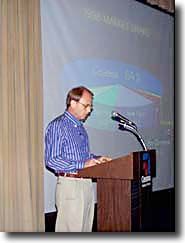 CessnaVice Chairman Gary Hay seemed upbeat Friday morning as he told a gathering of journalistsat EAA Headquarters that business is very good, and that the growing demand for generalaviation airplanes seems to be benefiting Cessna more than others. Part of this is due toCessna’s return to building single-engine piston airplanes. With all five announcedsingle-engine models – 172, 172SP, 182, 206, T206 – all in full-scale production, Cessnahas in just over a year established a 64% market share in new single-engine salesworldwide.
CessnaVice Chairman Gary Hay seemed upbeat Friday morning as he told a gathering of journalistsat EAA Headquarters that business is very good, and that the growing demand for generalaviation airplanes seems to be benefiting Cessna more than others. Part of this is due toCessna’s return to building single-engine piston airplanes. With all five announcedsingle-engine models – 172, 172SP, 182, 206, T206 – all in full-scale production, Cessnahas in just over a year established a 64% market share in new single-engine salesworldwide.
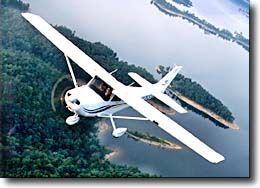 “It wasn’t easy, because we started with a group ofinexperienced team members down in Independence, and we started out in an all new facilityas well,” said Hay, “and to be completely candid, some of our early units werenot up to our standard of quality and service bulletins were…too many. We had tocorrect a lot of issues.” Hay added that the problems had been corrected and thequality of Cessna singles coming off the line “is now right where it ought tobe.” He also said that single-engine production rates were up to the point that a newSkyhawk could be ordered for “near-term availability,” while a new Skylaneordered today could be delivered in the fourth quarter of this year. There remains asignificant backlog of Skyhawk SP models, which has proven so popular that Hay predictedthat the 180-hp version would soon account for the lion’s share of 172 production. Firstcustomer deliveries of the 206 Stationair and and T206 Turbo Stationair are scheduled forNovember and December, respectively.
“It wasn’t easy, because we started with a group ofinexperienced team members down in Independence, and we started out in an all new facilityas well,” said Hay, “and to be completely candid, some of our early units werenot up to our standard of quality and service bulletins were…too many. We had tocorrect a lot of issues.” Hay added that the problems had been corrected and thequality of Cessna singles coming off the line “is now right where it ought tobe.” He also said that single-engine production rates were up to the point that a newSkyhawk could be ordered for “near-term availability,” while a new Skylaneordered today could be delivered in the fourth quarter of this year. There remains asignificant backlog of Skyhawk SP models, which has proven so popular that Hay predictedthat the 180-hp version would soon account for the lion’s share of 172 production. Firstcustomer deliveries of the 206 Stationair and and T206 Turbo Stationair are scheduled forNovember and December, respectively.
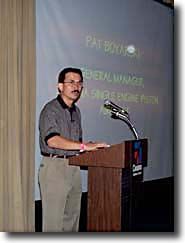 Pat Boyarski, GeneralManager of Cessna’s Single Engine Division, noted that in the year since Oshkosh ’97, morethan 625 single-engine airplanes were delivered by Cessna’s Independence single-engineassembly facility, and employment had grown to the full staffing level of about 850.Production of both the Skyhawk and Skylane is at full planned rate. Meanwhile, the first206 and T206 aircraft have come off the end of the Independence production line, movedthrough the paint shop, and are now being fitted with interiors prior to beginning flighttest. Boyarski said that Cessna has four 206 and T206 aircraft dedicated to certificationwork, including one being used by AlliedSignal
Pat Boyarski, GeneralManager of Cessna’s Single Engine Division, noted that in the year since Oshkosh ’97, morethan 625 single-engine airplanes were delivered by Cessna’s Independence single-engineassembly facility, and employment had grown to the full staffing level of about 850.Production of both the Skyhawk and Skylane is at full planned rate. Meanwhile, the first206 and T206 aircraft have come off the end of the Independence production line, movedthrough the paint shop, and are now being fitted with interiors prior to beginning flighttest. Boyarski said that Cessna has four 206 and T206 aircraft dedicated to certificationwork, including one being used by AlliedSignal 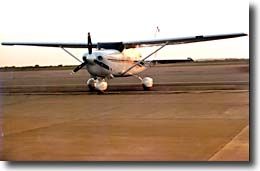 for autopilot certification, and said that”certification is on track and on schedule to support deliveries of the Stationair inNovember and the Turbo Stationair in December.” Boyarskiindicated that university aviation programs represented a significant part of the demandfor new Skyhawks. He announced that Embry-Riddle Aeronautical University, which last yearcommitted to purchase 300 aircraft over 12 years, had doubled its originally plannedSkyhawk deliveries for 1998, resulting in a total of 46 Skyhawks to be delivered thisyear. Western Michigan University has taken delivery of 19 Skyhawks, and Le TourneauUniversity in Longview, Texas, took delivery of five new Skyhawks a few weeks ago. 1998fleet sales also included 20 new Skyhawks delivered to the Civil Air Patrol for deploymentin CAP wings across the country.
for autopilot certification, and said that”certification is on track and on schedule to support deliveries of the Stationair inNovember and the Turbo Stationair in December.” Boyarskiindicated that university aviation programs represented a significant part of the demandfor new Skyhawks. He announced that Embry-Riddle Aeronautical University, which last yearcommitted to purchase 300 aircraft over 12 years, had doubled its originally plannedSkyhawk deliveries for 1998, resulting in a total of 46 Skyhawks to be delivered thisyear. Western Michigan University has taken delivery of 19 Skyhawks, and Le TourneauUniversity in Longview, Texas, took delivery of five new Skyhawks a few weeks ago. 1998fleet sales also included 20 new Skyhawks delivered to the Civil Air Patrol for deploymentin CAP wings across the country.
…While Cessna Pilot Center Programs Are Ready For Prime Time
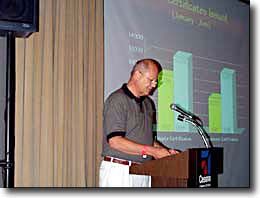 Cessna VP-Marketing PhilMichel provided an update on Cessna’s complete makeover of their Cessna Pilot Centerflight school program. He started by reviewing industry efforts through the GA Team 2000initiative to persuade more people to learn to fly, and said that the effort is clearlystarting to pay off. Last year, FAA figures showed student starts up by 8.3% last year,and thus far this year they are running ahead of last year’s turnaround figures. Newprivate pilot certificates for the first six months of 1998 are up 40%, and instrumentratings are up 80%, which Michel characterized as “really encouraging news.”
Cessna VP-Marketing PhilMichel provided an update on Cessna’s complete makeover of their Cessna Pilot Centerflight school program. He started by reviewing industry efforts through the GA Team 2000initiative to persuade more people to learn to fly, and said that the effort is clearlystarting to pay off. Last year, FAA figures showed student starts up by 8.3% last year,and thus far this year they are running ahead of last year’s turnaround figures. Newprivate pilot certificates for the first six months of 1998 are up 40%, and instrumentratings are up 80%, which Michel characterized as “really encouraging news.”
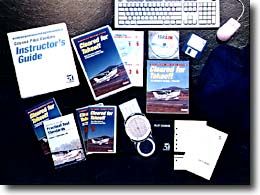 Michel then introducedCessna’s new Computer Based Instruction private pilot groundschool program, developed forthe Cessna Pilot Center program by King Schools. With Martha King manning the computerkeyboard and mouse, Michel walked the group through a few lessons from the CBI course,showing off its interactive multimedia capabilities and how much fun it is compared to atraditional classroom setting. The course material was clearly developed with a lot ofcleverness and humor. The new CPC Private Pilot Student Kit course includes over 24 hoursof video clips (mostly in 5-minute segments), 467 interactive questions, two practiceexams, and three programmed quizzes. Although there is a textbook included in the kit,Michel said it was “not only possible but entirely practical for the first time everto become a safe, accomplished pilot entirely through computer ground instruction…thestudent would never have to crack a book.”
Michel then introducedCessna’s new Computer Based Instruction private pilot groundschool program, developed forthe Cessna Pilot Center program by King Schools. With Martha King manning the computerkeyboard and mouse, Michel walked the group through a few lessons from the CBI course,showing off its interactive multimedia capabilities and how much fun it is compared to atraditional classroom setting. The course material was clearly developed with a lot ofcleverness and humor. The new CPC Private Pilot Student Kit course includes over 24 hoursof video clips (mostly in 5-minute segments), 467 interactive questions, two practiceexams, and three programmed quizzes. Although there is a textbook included in the kit,Michel said it was “not only possible but entirely practical for the first time everto become a safe, accomplished pilot entirely through computer ground instruction…thestudent would never have to crack a book.”
The new CPC program also includes a comprehensive “course management module”that permits the flight school to track the progress of each student. Michel emphasizedthat the CBI course is complete, and that the first students are already in training usingthe new technology. “We’ve only just begun the process of introducing this newprogram to Cessna Pilot Centers around the country, but their reaction and the reaction ofthe new students has been just fantastic,” said Michel. “It’s not often that weget to be part of any genuine breakthrough in any field of endeavor, but we truly believethat you’ve just seen the future of flight training, and it’s here today,” heconcluded.
…And Reporters Get A Glimpse Into Cessna’s Future
In the Q&A session that followed, Gary Hay said that Cessna was following variousR&D initiatives by various powerplant manufacturers (not just Lycoming) with greatinterest, and believed that there was significant opportunities for breakthrough advancesin the next few years. Hay specifically mentioned Diesel engines, single-lever engine controls, and anew 1,200-pound-thrust turbofan engine being developed by Williams thatwould be suitable for a 6,000 to 7,000 pound aircraft. Asked about additionalsingle-engine piston models, Hay said that the R182 (retractable gear) was being seriouslyconsidered and that market research showed an “obvious demand” for such anaircraft. “No plans at the present time, but we’re looking at it,” Hay added. Inresponse to a question about follow-on CBI course materials, Hay said that an InstrumentRating course was the next project that Cessna would be asking King Schools to develop. Healso indicated that Cessna was very close to announcing a “shared ownership”program for new Cessna singles where two to six individuals would jointly purchase a newaircraft. Finally, one journalist asked Hay about possibility of Cessna resumingproduction of the 210. “There are lots of 210s out there right now,” respondedHay, chuckling. “Are there gonna be more?” the questioner persisted.”That’s a good question,” parried Hay, “we’ll reserve that one for Oshkoshnext year.”
SPecial Day for Cessna
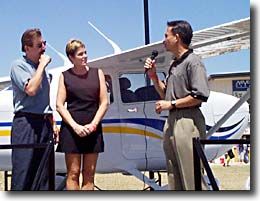 Hehas 155.6 hours in his logbook and by next week, will have a new Cessna 172 SP in hishangar. Family practice doc Paul Hankerson and wife Denise took possession of the keys tothe very first SP Friday at Oshkosh. Cessna Single-Engine Division General Manager PatBoyarksi and Suburban Aviation President Tom Trumbull did the honors and stood smilinglyby. Unfortunately the good doctor will have to cool his heels a bit longer-the plane isCessnas Oshkosh display model and will be delivered to Hanersons Okemos,Michigan, home after the show is over.
Hehas 155.6 hours in his logbook and by next week, will have a new Cessna 172 SP in hishangar. Family practice doc Paul Hankerson and wife Denise took possession of the keys tothe very first SP Friday at Oshkosh. Cessna Single-Engine Division General Manager PatBoyarksi and Suburban Aviation President Tom Trumbull did the honors and stood smilinglyby. Unfortunately the good doctor will have to cool his heels a bit longer-the plane isCessnas Oshkosh display model and will be delivered to Hanersons Okemos,Michigan, home after the show is over.


































